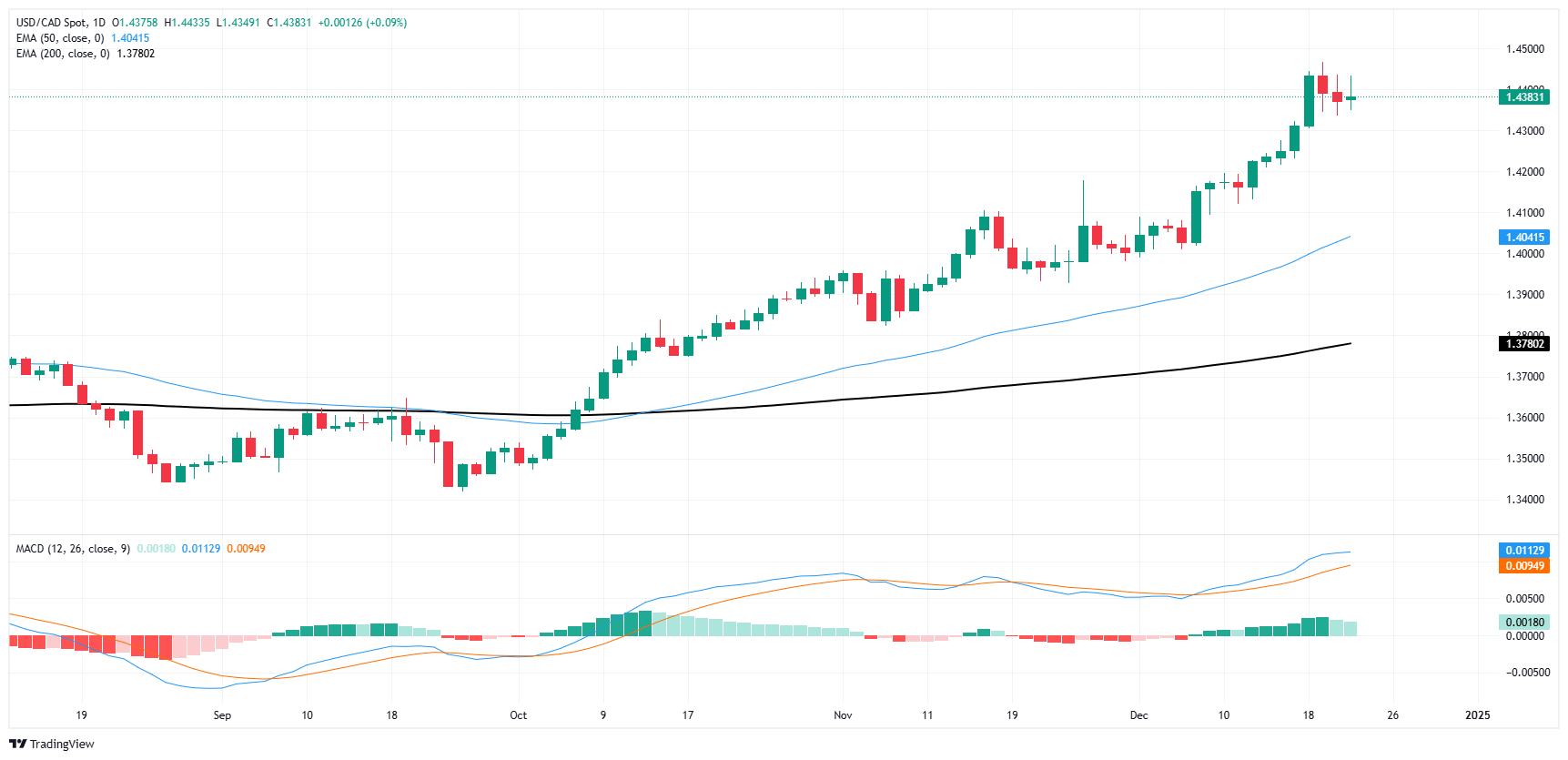Canadian Dollar hung near recent lows despite GDP uptick
- The Canadian Dollar shed 0.2% on Monday despite CAD data beats.
- Canada saw a rebound in GDP growth figures, as well as easing inflation metrics.
- A holiday-crimped trading schedule and declining US Durable Goods Orders keep bulls at bay.
The Canadian Dollar (CAD) shed roughly one-fifth of one percent against the Greenback on Wednesday. Risk sentiment is easing to kick off the new trading week, with the safe haven US Dollar catching a bid and market flows drying up ahead of the Christmas holiday.
Canada’s October Gross Domestic Product (GDP) rose to its highest point since June, beating forecasts, and the Canadian Raw Material Price Index fell back more than expected in November. US Durable Goods Orders contracted sharply in November, falling at their fastest rate MoM since July.
Daily digest market movers: Market volumes wane ahead of Christmas holiday
- Canadian GDP rose 0.3% MoM in October, over and above the forecast decline of 0.1%. September’s print was also revised to 0.2% from 0.1%.
- Canada’s Raw Material Price Index contracted 0.5% in November, sharply lower than the previous month’s 4.0% upswing and falling even further below the expected 0.6% increase.
- Despite the sharp drag on raw materials, Canadian Industrial Product Prices rose 0.6% in November, less than the previous month’s 1.2% but above the forecast 0.3%.
- Despite improving Canadian growth and inflation figures, overall market sentiment remains hobbled by holiday market volumes and a broad miss in US Durable Goods Orders.
- US Durable Goods Orders contracted by 1.1% in November, falling sharply below the forecast -0.4% and walking back the previous month’s revised 0.8% upswing.
Canadian Dollar price forecast
The Canadian Dollar (CAD) continues to show no sign of internal strength, languishing near the 1.4400 handle against the US Dollar and splashing around multi-year lows. USD/CAD remains well-bid, and the pair is opening up a fresh trading week on the heels of a fourth consecutive weekly gain.
Loonie bulls will be watching the charts closely for a momentum play to drag USD/CAD back down the charts, but even they will likely be waiting until the new year before looking for short entries. The pair is set to continue grinding out chart paper near the 1.4400 region as markets await the kickoff of the 2025 trading season.
USD/CAD daily chart
Canadian Dollar FAQs
The key factors driving the Canadian Dollar (CAD) are the level of interest rates set by the Bank of Canada (BoC), the price of Oil, Canada’s largest export, the health of its economy, inflation and the Trade Balance, which is the difference between the value of Canada’s exports versus its imports. Other factors include market sentiment – whether investors are taking on more risky assets (risk-on) or seeking safe-havens (risk-off) – with risk-on being CAD-positive. As its largest trading partner, the health of the US economy is also a key factor influencing the Canadian Dollar.
The Bank of Canada (BoC) has a significant influence on the Canadian Dollar by setting the level of interest rates that banks can lend to one another. This influences the level of interest rates for everyone. The main goal of the BoC is to maintain inflation at 1-3% by adjusting interest rates up or down. Relatively higher interest rates tend to be positive for the CAD. The Bank of Canada can also use quantitative easing and tightening to influence credit conditions, with the former CAD-negative and the latter CAD-positive.
The price of Oil is a key factor impacting the value of the Canadian Dollar. Petroleum is Canada’s biggest export, so Oil price tends to have an immediate impact on the CAD value. Generally, if Oil price rises CAD also goes up, as aggregate demand for the currency increases. The opposite is the case if the price of Oil falls. Higher Oil prices also tend to result in a greater likelihood of a positive Trade Balance, which is also supportive of the CAD.
While inflation had always traditionally been thought of as a negative factor for a currency since it lowers the value of money, the opposite has actually been the case in modern times with the relaxation of cross-border capital controls. Higher inflation tends to lead central banks to put up interest rates which attracts more capital inflows from global investors seeking a lucrative place to keep their money. This increases demand for the local currency, which in Canada’s case is the Canadian Dollar.
Macroeconomic data releases gauge the health of the economy and can have an impact on the Canadian Dollar. Indicators such as GDP, Manufacturing and Services PMIs, employment, and consumer sentiment surveys can all influence the direction of the CAD. A strong economy is good for the Canadian Dollar. Not only does it attract more foreign investment but it may encourage the Bank of Canada to put up interest rates, leading to a stronger currency. If economic data is weak, however, the CAD is likely to fall.


